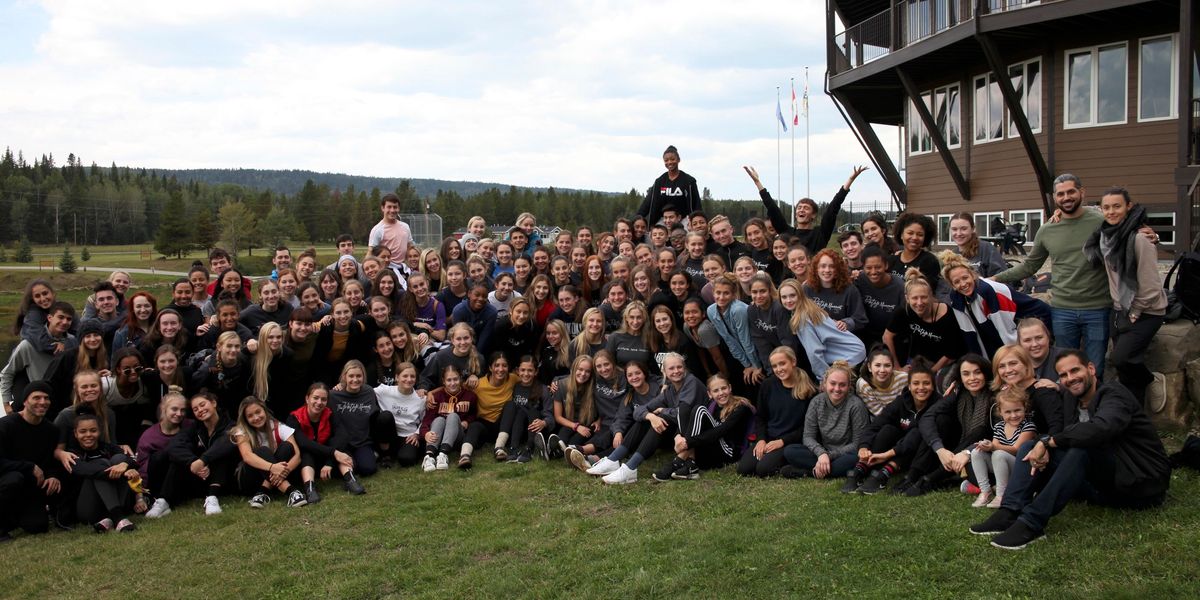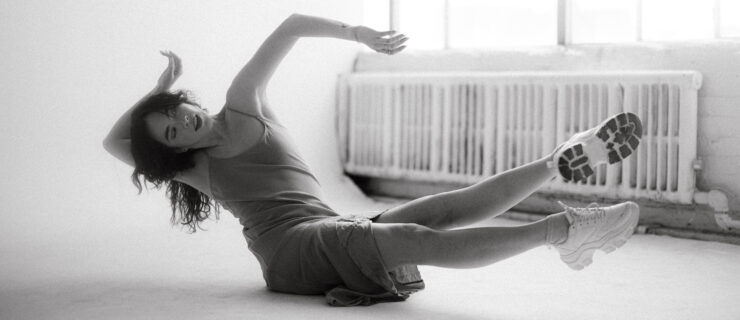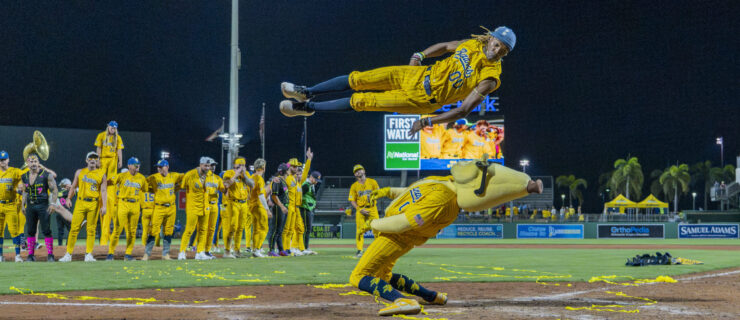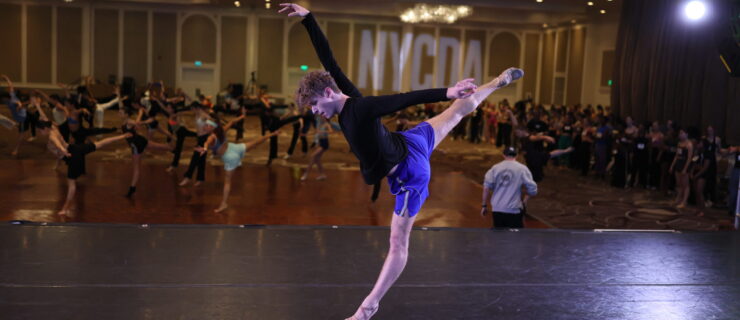An Exclusive Look at Stacey Tookey's One-of-a-Kind, Cell Phone-Free Summer Intensive
All photos Anna Marchisello and Jacob Patrick (courtesy Stacey Tookey)
Deep in the hills just outside Calgary, Alberta, Camp Kindle sits unassumingly, nestled in a forest clearing. With rustic cabins, a glassy lake, sprawling lawns, and a giant ropes course, the scene looks like the set of an old-school movie about summer camp- which is why it’s so surprising to learn that, for one week each August, some of the competition circuit’s most gifted dancers arrive there en masse for Stacey Tookey’s Camp Protégé.
“Camp,” as it’s often referred to by the dancers and faculty, was founded by Tookey in 2016 as a part of her Protégé Movement, which is a series of three-day intensives in L.A., NYC, and Toronto. In the three years since, a spot at Camp has become one of the most sought-after trophies in the competition-convention world, thanks in large part to the unprecedented access to top-tier faculty and unique setting. But beyond that, Tookey has created a world where judgement, self-doubt, and distractions are stripped away and replaced with a sense of safety—in Tookey’s words, “Permission to be free.” Dance Spirit went inside this one-of-a-kind intensive for a firsthand look.
 Dancers group hug after class.
Dancers group hug after class.
Total Isolation
Upon arriving, one thing becomes immediately clear: Whether you like it or not, you’re off the grid. “It was a little shocking at first,” remembers Tate McRae, who’s been attending Camp since the first year. “You have a mini anxiety attack when you realize there’s zero cell service, but you become so aware of everything around you, which is what makes the week so special.” Parents and guardians are notified by the staff once the dancers have safely arrived, but after that, getting in touch via cell phone is next to impossible— which is a blessing in disguise. Tookey knows just how plugged in this generation of dancers is. “I don’t think they even realize just how addicted they are to their phones, until they get here,” she says. “They need to disconnect, because removing the external gratification of, say, hundreds of likes on an Instagram post forces them to find confidence internally, and helps them grow as people.” To fill the phone void, Tookey gives each dancer a journal and a pen at the start of Camp, and encourages them to write down everything they’re feeling over the course of the week- time that, everyone admits, would usually be spent scrolling through IG.
 Protégés enjoy off the grid moments in Camp’s scenery.
Protégés enjoy off the grid moments in Camp’s scenery.
Jam-Packed Days
Days at Camp start around 7 am with breakfast, then group yoga and meditation. “I like to start and end every day together,” Tookey says. Afterwards, dancers break into groups and head to two classes before lunch, and three before dinner. Classes include technigue, choreography, an assortment of nutrition and self-care lessons, acting classes, neuromuscular training, Q&As, and a camp activity like a ropes course. The day ends with dinner and a wrap up class with all the students and faculty.
“It’s About Dancing for Yourself”
Creating a safe, accepting place is Tookey’s main goal for Camp, something comp-circuit standout Timmy Blankenship felt right away. “Stacey truly created a space that was filled with total acceptance,” he says. “There are no cameras, no judgment. It’s about dancing for yourself.” “I want every dancer to feel connected, loved, and safe,” Tookey says. “We’re all working towards the best versions of ourselves, together.”
 Chantel Aguirre (front) leading a warm up before class
Chantel Aguirre (front) leading a warm up before class
Going with the Flow
“We have a schedule, but often we just follow the vibe of the day when it comes to the dance classes,” Tookey says. This organic approach is a highlight for lots of the dancers, including USC Kaufman student Elise Monson, who’s attended Camp twice and has assisted Tookey at Protege in L.A. “Stacey wanted Camp to act as a mentorship program for us, and it really does feel like life training,” she says. “Rather than just spending time trying to execute a set combination, the classes shape us as humans. We talk about our struggles, our successes, what makes us feel scared, what makes us feel free. It was so much more holistic than a standard convention.” Tate agrees. “Classes are where the magic happens. They’re totally unpredictable and the energy is crazy. You can end up improvising for an hour, just talking, or all crying together!”
 Morning yoga class
Morning yoga class
 Dancers and faculty during a wrap up class
Dancers and faculty during a wrap up class
Faculty Equals Family
The faculty at Camp is made up of some of the comp circuit’s biggest names, including Kathryn McCormick, Jason Parsons, and Chantel Aguirre. But unlike a convention weekend, they’re not just teaching class and heading back to their hotel rooms. “We’re all living together, eating meals together, and bonding,” Tookey says. “I want the dancers to be able to walk up to the faculty members with questions, concerns, or whatever else. I wouldn’t be where I am today without my mentors, so I want to nurture this next generation and pay it forward.”
 (From left) Jacob Patrick, Kathryn McCormick, Jenn Perry, Heather Lang, Chantel Aguirre, Stacey Tookey’s daughter Harper, Tookey, Gene Gabriel, and Jason Parsons
(From left) Jacob Patrick, Kathryn McCormick, Jenn Perry, Heather Lang, Chantel Aguirre, Stacey Tookey’s daughter Harper, Tookey, Gene Gabriel, and Jason Parsons
More Than Connected
If there’s one thing dancers walk away with from Camp, it’s a deep connection with their fellow Protégés. “Because we don’t have our phones and are dancing nonstop, we’re constantly engaged in physical and emotional contact,” Monson says. “That breaks boundaries and creates very special, lifelong connections.”
 Dancers debrief Camp experiences
Dancers debrief Camp experiences
A version of this story appeared in the Summer 2019 issue of
Dance Spirit with the title,”This Must Be The Place.”














